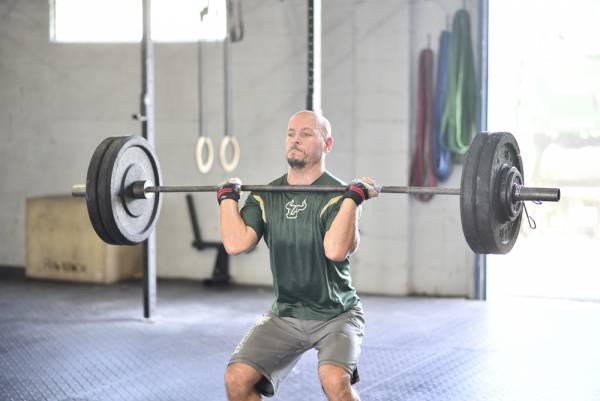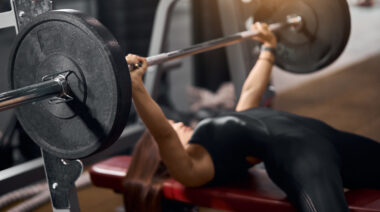Most of us know what habits to avoid if we are looking to stay injury free and perform our workouts optimally. But what we don’t realize is that some of our seemingly harmless daily rituals can stress and strain our anatomy, hinder our progress, and even set us up for a future injury.
Here are five habits that may be hurting your workouts:
1. Stomach Sleeping
The Problem: Sleeping on your stomach causes hyperextension and compression in the lumbar spine and strains muscles in the neck and posterior chain. If you think stomach sleeping is no big deal, give this a try: turn your head to one side and hold it that way for a couple hours. Feel good? That’s essentially what you’re doing for seven to eight hours every night.
Doing this every night for years slowly adds pressure to the joints and nerves, contributing to spinal degeneration and allowing for the development of a variety of health problems. This positioning can also lead to loss of range of motion and nerve root irritation. All of these things will hinder your workouts, from squats and deadlifts to any overhead movements.
The Solution: Your bed and pillow should help keep your body in natural alignment. If you’re currently a stomach sleeper, begin training yourself to sleep on your back or side. It’s not easy, but seeing as you spend about a third of your life in this position, your body (and your workouts) will thank you. Choose a pillow that supports the head so that the neck vertebrae are neutral (level with the rest of your spine). Also, use a good mattress that prevents your spine from dipping or sagging while you sleep.
2. Cracking Your Neck
The Problem: The neck is one of the most sensitive and important pieces of anatomy in the human body. It amazes me that someone would think it’s a good idea to self adjust it. It’s not the sound that is the problem (which comes from tiny gas bubbles within the fluid that lubricates your joints), it’s the way the thrust affects your spine. Self-manipulation, while a temporary rush and feel-good sensation, can create hypermobility and long-term structural problems.
<em”>”Whenever you get the chance to include some physical activity into your day, you should.”
In addition, people who self-manipulate their necks tend to do it several times a day, every day. This causes ligaments to stretch and eventually become less stable – not a good thing when it comes to movement. This instability not only affects the mechanics of the cervical spine, but also can predispose you to a neck injury while lifting.

The Solution: Postural corrective exercises can be performed to strengthen the upper back and neck. Massage therapy can be performed to address the muscular dysfunction and trigger points. However, if the “need” to self-adjust is due to a shifting of the spine, then this must be addressed, or a correction will often not occur. In my office, I use specific adjustments to correct these shifts. These allow your body to make corrections naturally and to the extent that is capable for you.
3. Grinding Your Teeth
The Problem: Teeth grinding can result in damage to the jaw joint – what we call temporomandibular joint disorder (TMJD). In addition to the jaw pain and headaches that occur with TMJD, many people suffering from this disorder will also experience neck and shoulder pain. This is because the nerves that run through the temporal mandibular joint have branches that also travel down the neck and into the shoulders. Constant grinding can lead to inflammation and swelling around these nerves, affecting not only the jaw but where the nerves travel as well. This can lead to chronic neck and shoulder problems, hindering your progress in training.
“[W]hat we don’t realize is that some of our seemingly harmless daily rituals can stress and strain our anatomy[.]”
The Solution: Self-awareness programs and instructions from dentists can help you recognize daytime clenching and bracing, as well as any other habits that result in jaw muscle contraction. Yoga, breathing exercises, and meditation are great to prevent tension. In addition, custom-fit mouth guards that you can wear them all day (except when eating) can help train the jaw not to clench. At home, self-massage techniques you can do include lying on your side and resting your cheek on tennis ball for two to three minutes. The sustained pressure tricks your brain into relaxing the jaw muscles.
4. Excessive Sitting
The Problem: Our bodies were not designed to sit for long periods of time. We were designed for movement, yet the average workday for most Americans involves sitting for the majority of the time. When you sit all day, your hip flexors and hamstrings shorten and tighten, while the muscles that support your spine weaken and become stiff. This weakness, especially in the glutes, pushes your pelvis forward, putting increased pressure on the lumbar spine. In addition, the fascia that connects your muscles begins to set and this dysfunctional posture slowly becomes your normal posture.

And that’s just the lower back. Sitting also typically involves your head being pushed forward, which can cause headaches and neck and shoulder pain. Your body will adapt to what you do most often. If you spend the majority of the day sitting and not active, you are setting yourself up for muscle stiffness, poor balance and mobility, and lower-back, neck, and hip issues.
The Solution: A simple change in how you view being fit can make all the difference. Instead of viewing fitness as a 45-minute workout in the gym, view it as being active throughout the day. Whenever you get the chance to include some physical activity into your day, you should. Take small breaks as frequently as possible. Use a smaller water cup so you have to refill it more often. Do a lap around the office. Ask for a stand-up desk. Step outside for a minute to get some fresh air. Stand while you’re talking on the phone. It all adds up, and it all matters. When you must sit, make sure you have a high-quality chair with adjustable arms and height, lumbar support, and ample padding.
5. Picking Things Up Incorrectly
The Problem: If you have bad mechanics picking up something off the ground (basically a squat), then you are setting your set up for faulty movement patterns in other aspects of your life (like the gym). It also means these faults will be present when you jump or land. This will lead to injury. It’s important to be consistent with your movements – even the normally thoughtless ones like picking up something off of the floor. Learning proper movement in the simplest of tasks can have far-reaching implications in other aspects of your life.
“[A] squat, getting up off the couch, and picking something up are all basically the same movement[.]”
The Solution: Bad form can be fixed by learning the proper movement, and bad form due to a decreased range of motion can be fixed through regularly practicing mobility exercises. Once you learn how to squat correctly, then use those proper mechanics throughout your day, not just in the gym. After all, a squat, getting up off the couch, and picking something up are all basically the same movement – and therefore should have the same technique.
Learn more from these related articles on Breaking Muscle:
- How Your Recovery Relates Directly to Your Performance
- 3 Ways to Heal a Stiff Neck
- Snore No More – Relieve Neck Tension
- Breaking Muscle Home – Latest Articles
Photos 1 and 3 courtesy of Shutterstock.
Photo 2 courtesy of CrossFit Empirical.






